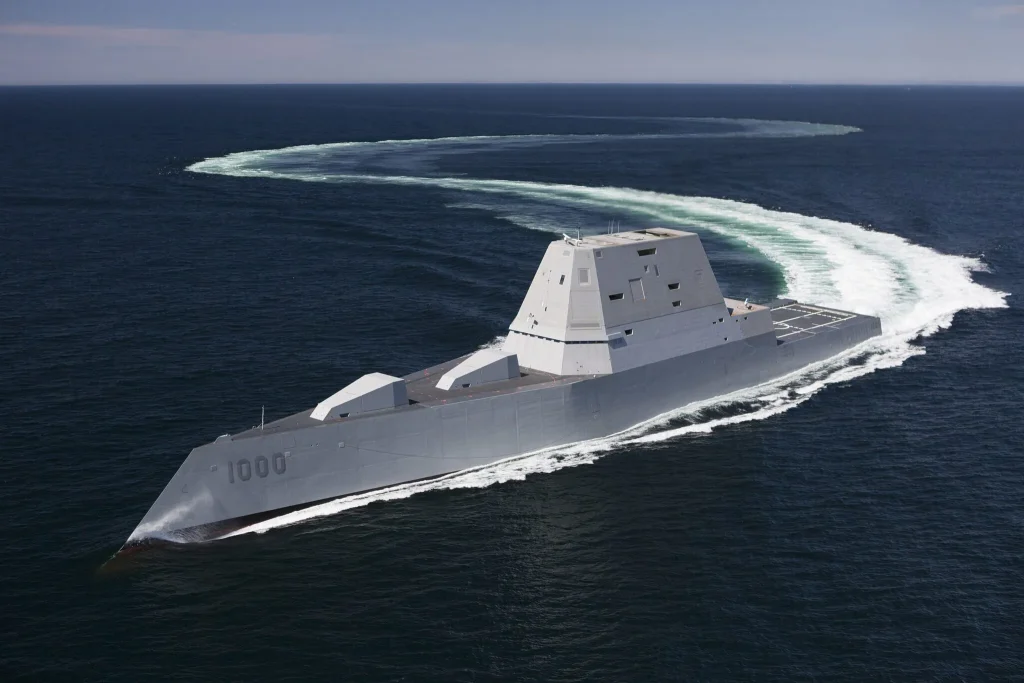Keel was approached to manufacture launch module/missile tubes for the U.S. Navy’s Zumwalt-class destroyer, the lead ship of a class of next-generation multi-mission destroyers designed to strengthen naval power from the sea. The assemblies are designed to replace advanced gun systems with long-range land attack projectiles and provide the stealth destroyer with the capability to launch Conventional Prompt Strike (CPS) hypersonic missiles.
The overall tube assemblies are significant in length upon assembly and in diameter at the muzzle end. The tube material is a high-strength alloy used in shipbuilding. There are multiple modules per shipset and each tube assembly can each hold multiple missiles. The sections will be assembled and then welded together at the ship integrator.
Business Challenges
- A tight schedule is required for the U.S. Navy’s high priority implementation to the fleet. The large subassemblies require large material handing equipment to complete this project. Therefore, existing capability and capacity is required to meet deadlines.
- The customer was looking for an experienced manufacturing team to complete the complex requirements, which include U.S. military standard (MIL-SPEC)- and Naval Sea Systems Command (NAVSEA)-specified materials and processes. Full-penetration welds require non-destructive testing (NDT) to ensure quality weld joints. Confirmation of overall length and positions are required before delivery to the ship integrator.
- Machining to tight tolerances on large machinery is a must. Turning and milling machines must be such that the large subassemblies can be oriented for the material removal to be completed. Additional machined features are to be added once the design is complete. These added features, after the initial release, should have minimal schedule impact.
Approach and Solution
Split tube halves are manufactured from plate and then formed into tube sections. These tube sections are joined by submerged arc welding (SAW) to form “barrels.” Keel uses experienced weld staff to run semi-automated SAW welding manipulators, which are able to handle the long reach on the parts. On-staff NDT technicians – led by Keel’s own ASNT Level III NDT technician, experienced weld engineers and certified weld inspectors – ensure high-quality, full-penetration welds. Once these “barrel” tubes are welded, fitted with flanges for assembly and weld-inspected, the tubes are completely machined at Keel’s large machining facility in Michigan. Each end of the tube assembly is finished with fully machined forgings for an accurate fit for all mating components. Clocking of each section is marked in the machining process as they are critical for fit-up in the application.
Added mounting locations are machined into upper and lower sections on the exterior for ship fitment. These locations are precisely machined for mating mount clevises and shock-absorbing assemblies.
Value Delivered
It begins with precise planning to meet tight deadlines. The complex manufacturing process is organized by Keel’s Advanced Planning Excellence Center (APEX) using the IFS ERP system. All steps from procurement to product measurement are defined for the Keel manufacturing staff by APEX. Each assembly step is also scheduled at all Keel Michigan plants to ensure available capacity and conformance to the delivery schedule. At the same time, Keel’s purchasing department and supplier development group also work with our dependable supply partners to ensure materials are delivered on time and to specifications.
With a large staff of non-destructive technicians, Keel also has the depth and skills to ensure high-quality welded joints in the tube assemblies. Keel’s automated SAW experience is used for these demanding, “inclusion-free” full-penetration welded assemblies. With nearly two decades of automated SAW welding experience, Keel is an industry leader for this type of welding.
Keel is equipped to handle large-scale projects. Keel has the correct turning and milling machines in place to complete the tight tolerance on these large subassemblies. With existing machines, Keel can easily turn these large diameter, tall barrels. Additionally, Keel has multiple milling machines where the side details and flange joints can be processed and is capable of machining parts as long as 52 feet in one setup.

